“Baillot was one of the most significant and fascinating figures in the history of 19th-century violin playing, performance, and pedagogy.”
(M. Wulfhorst, The Strad , Feb. 2022)
“...during the first half of the 19th century Baillot occupied the same position in France that Joseph Joachim held in Germany during its second half: that of an all-encompassing instrumentalist—at the same time a dazzling soloist, quartet player, founder of famous concerts, interpreter of all high-quality music (not only his own), well-known pedagogue, all this somewhat at the expense of his work as a composer.”” (Brigitte François-Sappey 2015)
As a major representative of the French violin school,Pierre Marie François de Sales Baillot (1 Oct. 1771-15 Sep. 1842) played with impeccable left-hand technique, a big, beautiful sound, a large array of sophisticated strokes, and intense expressivity. Most important, he shaped and promoted a new aesthetics of performing, aimed at grasping and conveying the composer’s intentions. He championed not only Baroque violin works and the masterpieces of the French violin school but especially Viennese string quartets. He created a new performance format for this genre, the modern-day chamber-music concert. As a leading teacher of the Paris Conservatoire, which he joined in 1795 shortly after its foundation, he taught two generations of violinists. A prolific and sophisticated author, he wrote landmark pedagogical works (especially L’Art du violon), short essays on a variety of subjects, administrative documents, diaries and memoirs, and hundreds of letters. Though his compositionsare almost forgotten, some of his variation works and concertos deserve revival. Musicians and scholars have tapped only a fraction of the available digitized scores and documents.
.

Jean-Auguste-Dominique Ingres (1780–1867): Baillot, drawing, 1829
Ingres worked for a while as a second violinist in the orchestra of the Toulouse theater and later took violin lessons from Baillot.
© Martin Wulfhorst 2021 /R 2022
Pierre Baillot (1771–1842)
LINKS
This website, initiated on occasion of the 250th anniversary of Baillot's birth in October 2021, is intended as guide to research, materials, and information. A more comprehensive publication on Baillot is in preparation.